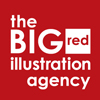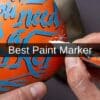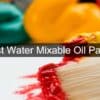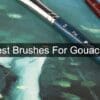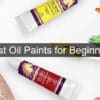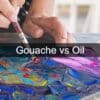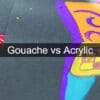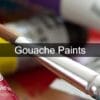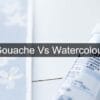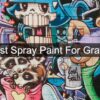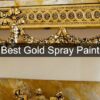Gouache vs Oil
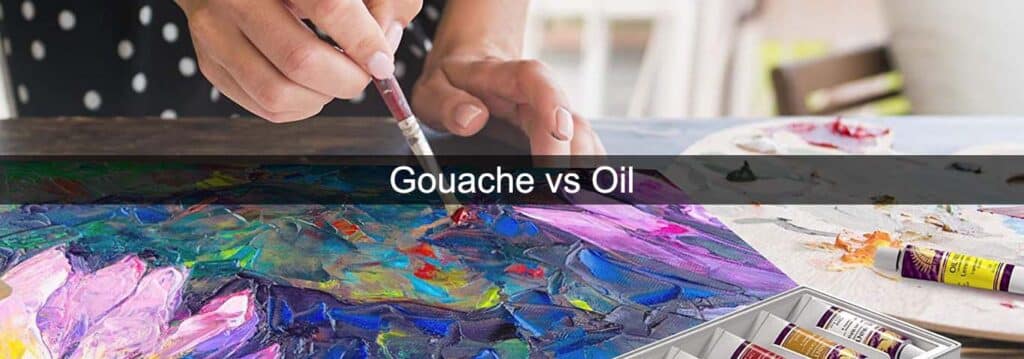
Remember the elementary days where we used to color our drawings with watercolor? Gouache is something similar to that. Gouache paint, like watercolor and acrylic paint, is a water media. Gouache is often described as an opaque watercolor. So, it is clear that most of us have met the art of gouache. But we can’t say the same for oil paints. Oil paint is more on the advanced side which was not usually introduced to us as elementary goers. Oil painting is the process of painting with pigments with a medium of drying oil as the binder. It has been the most common technique for artistic painting on wood panels or canvas for several centuries, spreading from Europe to the rest of the world.
Though both of the paints are totally different from each other. We still want to know more about their differences right? What we missed and what we didn’t! Take a look at the differences between these two paints and decide on which team you are.
Types of gouache and oil paints
Starting with the differences I think it is important to know their classifications first. Both of the paints have different classifications based on different binders.
There are two types of gouache. Traditional gouache and acrylic-based gouache. The difference? The first is water-soluble, just like watercolor paints. It reactivates with water after dry. If you paint on top of one layer it might get mixed with the color you’re using. The acrylic-based it’s more similar to acrylics, once dry it won’t reactivate again.
Unlike gouache, types of oil paints depend on the oil that is used in the paint. Commonly used drying oils include linseed oil, poppy seed oil, walnut oil, and safflower oil. The choice of oil imparts a range of properties to oil paint, such as the amount of yellowing or drying time.
Paper support for gouache and oil paints
To compare gouache and oil paint, the surface or the paper creates a huge difference. From a distance, paper or the canvas might not look like a major thing to compare but actually it is!
The Best Gouache paints work well on all types of paper but mostly on watercolor paper. One could also use some thick drawing paper. Talking about canvas, that’s typically better suited for acrylic gouache. However, the weight of the paper matters for gouache. Paper for painting with gouache should be at least 140 lb/300 gsm. High-quality watercolor paper is often gelatine sized, which makes it resistant to layering and wiping. Painting with gouache on a gray surface is a certain pleasure as the colors seem brighter on it. Gouache on hot-pressed watercolor paper spreads wonderfully on its smooth surface, and the texture of the paper doesn’t dominate the texture of the painting. For beginners, it is recommended to try to paint on hot-pressed watercolor paper first because it doesn’t absorb the water from the paints as fast as cold-pressed paper, so you won’t be bothered about the ratio of the paint and water.
On the other hand, the most common surface for oil paints, and one that has been used for centuries, is stretched primed canvas. Alternatives include wood panels and medium density fiberboard (MDF), which last a long time and will not bend. The best paper for longevity is all-cotton or cotton & linen rag paper, which is essentially the same material used to make artists work. 140 lb/300 gsm watercolor paper works well as it is heavy enough to take the weight of layers of primer and will not easily cockle from the moisture in the sizing.
Primer for both of the paints
A primer seals and protects the canvas, make it less absorbent, helps the colors stand out, and provides a smoother surface with enough tooth for the paint to bind onto. Gouache and oil paint requires two different techniques of primer.
Whatever priming you use in gouache, it should be a thin layer, thin enough so that the texture of the paper still shows through. You could use watercolor for the priming, but the idea of acrylia gouache or casein is that it should dry with a flat, even tone and be impervious to reactivation. Gesso is the most traditional primer for gouache. On primed canvases, the gouache paint will easily adhere to the surface; just remember to avoid painting in high humidity or over-stretching the canvas since although gouache is more robust than watercolor paints, it is of course still less compared to oil paints.
For oil paint primer keeps the paint solution from soaking into and eating away at the canvas fibers. It also keeps the canvas from turning brittle with age, as over time, oil oxidizes and makes the surface of the canvas more delicate and prone to cracking. You can coat it with an oil or latex bonding primer. If the original paint was really shiny, you’ll want to use a primer like Kilz. If it’s not too shiny, you can use a latex primer, then put a couple of latex coats over it. Allow the primer to dry.
Brushes for gouache paints and oil paints
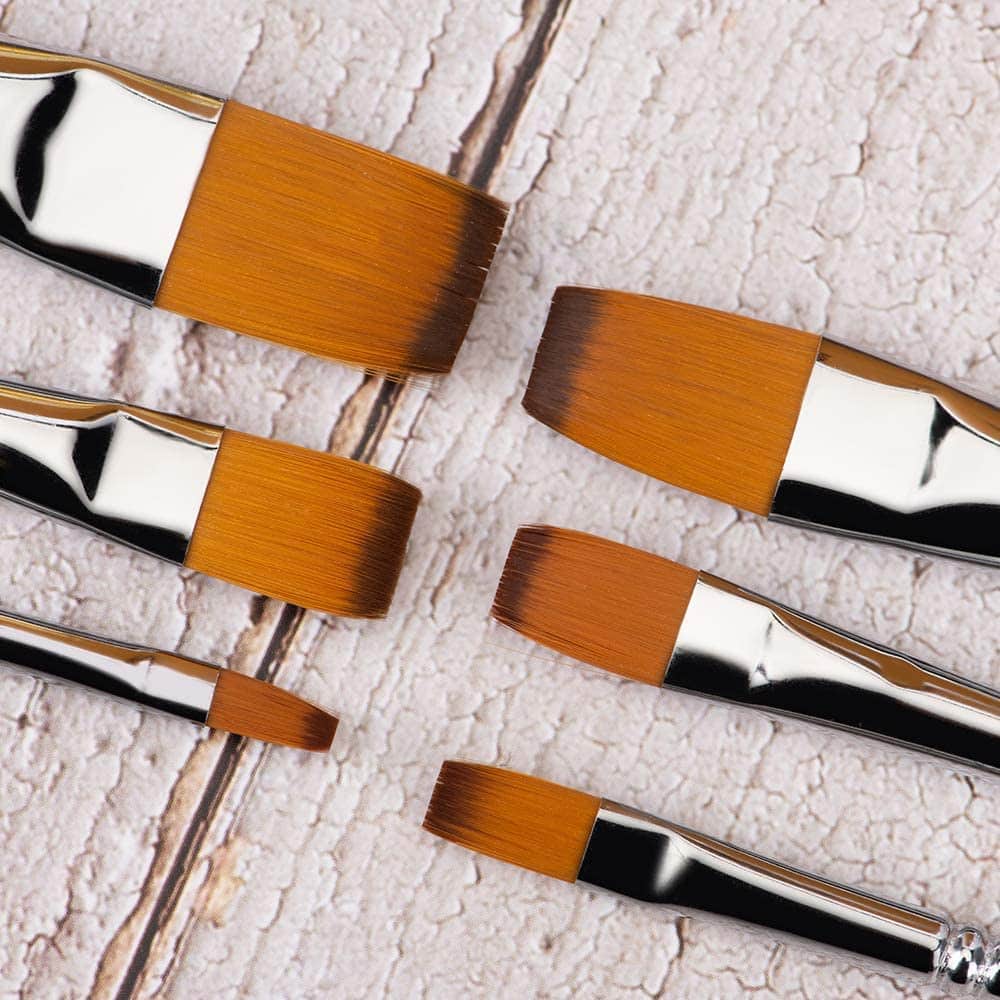
Brushes are a huge “Yes/No” between these two art paints.
For gouache painting, a flexible or soft-haired paint brush is best suited. Synthetic watercolor paint brushes are the best choice for gouache. You can use your watercolor brushes with gouache without fear of ruining them, and you won’t need to buy any special chemicals for clean-up because, like watercolor, gouache is water-soluble and can be cleaned up with water. If your watercolor brush is made from synthetic hairs, then you can use them with acrylic paint too. Be careful if it is made from natural hairs, as idedally you shouldn’t use them with acrylic paint.
Unlike gouache, best paint brush for oil painting is a natural bristle brush. Nylon bristles are recommended for opaque painting style, though most can also be used with oil paint. Natural hog bristle brushes are great because they have good stiffness and can hold more paint than synthetic brushes could. In oil painting, large bristle brushes are best for washes and broad areas of backgrounds. Mid-size bristle brushes with sharp edges can also be used for some detail. Finer details are best accomplished with small, thinner, round, sable brushes.
Water or other mediums for gouache and oil paints
Use of water or other mediums like oil or turpentine creates major difference between these two paints.
Gouache paint is a water-based medium, so you can water it down to react and move around like opaque watercolor. It is an extraordinary medium that expresses characteristics of watercolor and acrylic all while managing to hold its own and come out on top as a unique and impressive paint. It is typically diluted with water before being applied to a surface and similar to acrylic is rather dense. If you over-dilute your gouache, you can add a few drops of gum arabic to the mixture to thicken it again. Gum arabic is the binder used in gouache paint that helps the pigment bind to the paper once the water has evaporated. While acrylic, gouache, and watercolor paints are all water-soluble, they are applied differently to create a beautiful masterpiece.
While you can use water to thin water soluble oil paints, it may not be your best option. Straight water will often create a duller color and stickier paint that doesn’t brush easily or work well when other oils are added. The choice of oil imparts a range of properties to the paint, such as the amount of yellowing or drying time. Painting with a dry brush will give you a more textural effect, which is perfect for painting brick or dirt. The paint could be thinned with turpentine. Cooking oils such as canola or safflower are cheaper than solvents and, surprisingly – they work! The best choices are linseed oil, poppy seed oil, walnut oil, and safflower oil.
Finish look of gouache paints and oil paints
Both of the paints give two totally different finish looks. One is more into the matte finish side and the other one is on the shiny side.
Gouache paintings are very matte, non-shiny, and non-reflective. Gouache dries opaque and matte, and it can’t be watered down enough to look translucent like watercolors can. If applied too thickly, gouache paint can crack. The surface of dry paint looks almost velvety to the touch. If the brush leaves chalky-like marks on the paper, it means you need more water.
A glossy finish is one of the most popular finish looks of oil paint. But just because you are painting with oils doesn’t mean you will have glossy results. Sometimes, using some specific primer or products on the canvas or with paint can give you a matte finish with oil paint. Generally, oil colors become touch dry in thin films within 2 to 12 days, but the different reactions of different pigments when mixed with oil results in varying drying times, which will affect your work. There are many different reasons artists choose to paint with oil paint. While numerous blending capabilities, longer working time, rich and vibrant colors are some of the reasons.
Varnishing the art
Dust and grime can accumulate on the surface of paintings over time, especially if a painting hangs in a smoky environment. The protective layer of varnish can be removed to restore the painting to its original look.
Varnishing a gouache painting should be avoided because it changes the appearance, texture, and feel of the paper substrate. The varnish drastically affects the depth, darkness and finish of the work. And if anyone wants to retouch the painting again at some point in the future, perhaps for restoration purposes, the varnish will not come off. So, what can we do to preserve it? Once you’re done gouache painting, you can apply an isolation coat to it. This coat will create a permanent barrier. Any varnish added after this coat can be removed safely. Most removable varnishes can be removed with turpentine or mineral spirit. The isolation coat has to be a non-yellowing non-removable clear acrylic medium that permanently seals the surface of the painting. Being a water-based paint, gouache can be destroyed by an errant droplet of water. It can be made water resistant by mixing with acrylic paints and different mediums. But the more medium you add, the deeper the tone will become and you will reduce the characteristic matte gouache finish. With too much sun exposure, the colors may start to fade and become less saturated than when initially put down.
It’s necessary to varnish an oil painting in order to protect the paint film. Since resin is the essential ingredient of varnish, it’s more convenient to purchase a varnish than to make your own. There are traditional varnishes made with traditional resins, the most common of which is damar. One can use light even strokes to spread the varnish around the piece consistently. It is recommended to apply one to three thin layers rather than big thick layers.
CLEANING THE ART
Cleaning is the most important part of preserving beautiful paintings. Whether it’s two days old or two hundred centuries old, you just have to clean it to keep it fresh and lively.
The best way to clean gouache paint and water-based paints is to brush away dirt and dust with a soft-bristle paint brush. Other than this, gently soaking them to loosen up the dried paint, and then cleaning them with gently warm soap and water and a gentle hand soap or brush cleaning fluid is also fine. You can use spray fixative for a bit of protection, but nothing will keep it absolutely safe without ruining some of its qualities.
But if we look at oil paints, then the simplest way to clean up oil or acrylic paints on canvas is to use a white cotton cloth soaked in gentle soapy water. Olive oil–based soap works like magic in this case. You’ll be surprised to see how much grime comes off. You just have to be gentle with paintings with thick impasto as you do not want to break hardened paint. Sunlight can cause irreversible damage to oil paintings, ranging from loss of sheen and vibrancy to darkening of the varnish.
GOUACHE VS OIL VS ACRYLIC PAINT
Gouache, oil, and acrylic paint; three of them have totally different binders, different finishing and textures.
The most common binder employed in gouache is a combination of gum arabic, various plasticizers and preservatives. For oil painting, the pigments mixed with a medium of drying oil works as the binder. Again for acrylic paint, acrylic polymer plays the role of its binder and this forms a film after the water has evaporated. Water is the vehicle for water-based acrylic paint, and when combined with the binder, it creates a polymer emulsion.
FAQS
Which of them is recommended for beginners?
Both gouache and watercolor are known as great beginner mediums. So, getting started with gouache is fairly simple. You can later shift into acrylic paint also and then maybe oil paints.
Can gouache and oil paint mix together?
Oil paint should be just fine over acrylic gouache. In fact, it would probably adhere better over matte acrylic gouache than regular glossy acrylic paint. I would definitely not use oil over non-acrylic regular gouache because regular gouache is not strongly bound to the painting surface.
Is oil paint and gouache the same?
Oil paint is made with mineral pigments suspended in oil. Gouache is made with pigments suspended in a water-soluble binder. It’s clear that they are not the same as they don’t have the same binder.
Do professional artists prefer gouache or oil paint?
It depends on person to person, artist to artist. Usually, professional artists favor gouache for its versatility. It can mimic the look and feel of acrylic paint, watercolor, and even oil paints. It gives a matte finish, which is loved by most professionals.
Affiliate Disclosure
In compliance with the FTC guidelines, please assume the following about all links, posts, photos and other material on this website: Any/all of the links on this website are affiliate links of which The Big Red Illustration Agency receives a small commission from sales of certain items, but the price is the same for you. www.bigredillustrationagency.com is a participant in the Amazon Services LLC Associates Program, an affiliate advertising program designed to provide a means for sites to earn advertising fees by advertising and linking to Amazon.com & Amazon.co.uk. Pages on this site may include links to Amazon and its affiliate sites on which the owner of this website will make a referral commission.
FULL TERMS HERE Cookie preferences: cookie preferences

Written By Adam Rushton
Adam has made a name for himself in the illustration industry and is a passionate blogger and writer on the subject of art, illustration and graphic design.
His artwork has been featured in countless publications and used for very well-known media projects. As a professional illustrator for over 20 years, Adams media outlets, a wealth of knowledge, and experience enable him to consult and advise artists and illustrators in this country (from York and Manchester to Southampton and London) and all over the world.
